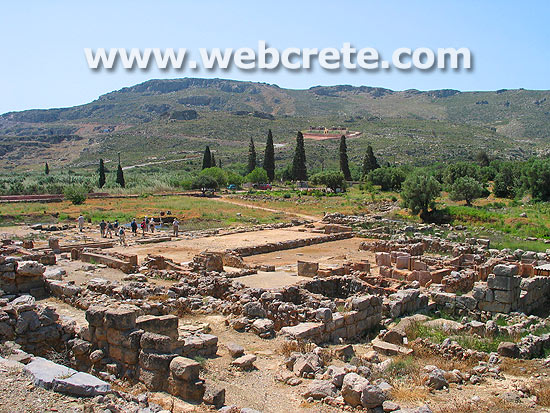
01 Jan Kato Zakros Minoan Palace
The palace at Zakros has two main building phases: the old palace was built in c. 1900 B.C., and the new one in c. 1600 B.C., but was destroyed in 1450 B.C. along with the other centres of Minoan Crete.
The palace at Zakros is the fourth in terms of size, among the Minoan palaces. It was located at an advantageous strategic position, at a protected bay, and was the centre of commercial exchange with the countries of the East, as is indicated by the excavation finds (elephants’ tusks, faience, copper etc.) The palace was the administrative, religious and commercial centre, and was surrounded by the town. After its destruction, it was not rebuilt and the site was used only for cultivation. Burials have been uncovered inside caves on the slopes of the “Ravine of the Dead”, as the ravine that stretches from Epano Zakros to Kato Zakros is called.
The finds from the excavation are exhibited in the Museum of Herakleion, while a few are kept in the Museums of Seteia and Aghios Nikolaos.
The most important buildings of the site are:
The palace and its annexes cover a total area of more than 8,000 sq.m.; it is estimated that in this area there were around 300 compartments – including the upper storeys – of various functions. The palace follows the basic plan of all Minoan palaces, with the main entrance on the east side; a second gate was located on the NE side, at the end of a stone paved road which came from the harbour.
A stepped corridor led down to the NE gate, and from there to the central court (measuring 30 x 12 m.). This court was actually the nucleus of the building and the place where religious ceremonies took place. It was surrounded by magnificent facades and porticos with columns-pillars which supported verandas, while at the NW corner there was a built altar.
The west wing was devoted to religious activity. The main entrance was opposite the altar in the court, and was flanked by two other smaller ones. The building had an antechamber, a chamber and a large “ceremonial” hypostyle hall (12 x 10 m.) with a peristyle light-well and polythyra (pier-and-door partitions), one of which gave access to a “banquet hall”, thus called because it contained amphoras and jugs. The west part of the wing is occupied by the shrine which consists of 11 rooms, some of which had niches. The main part of the shrine was a small room – not accessible to the public – with a high bench for the deposition of cult objects. Beside it there was a subterranean lustral basin, while to the south there were three auxiliary rooms: a stone cutter’s workshop, a storeroom, and the treasury – the only Minoan treasury which was found unrobbed and yielded a series of superb ritual vessels.
Further to the west is the archive room, which contained clay Linear A tablets in boxes, arranged on clay shelves. In the depositories of the shrine, religious objects were kept in brick compartments. In a later building phase, workshops were added outside the west facade.
The east wing included the royal quarters and the administrative centre: the “queen’s apartments” with polythyra (pier-and-door partitions), and the “king’s apartments”, the largest room of the palace. From the central court a polythyron led to the “hall of the cistern “, at the centre of which there was a circular underground cistern (diameter 7 m.) with a parapet supporting a row of at least five columns. Two more installations of such well-springs were located in this wing.
The south wing included a small complex of workshops for the production of perfume oils and small objects of faience, rock crystal etc.
In the north wing there is a large staircase leading to the upper floor, the “magazines of the royal quarters”, a bath complex and a spacious room, accessible from a corridor, interpreted as a kitchen which served the banquet hall on the upper storey.

 Search our website and read about
Search our website and read about 















